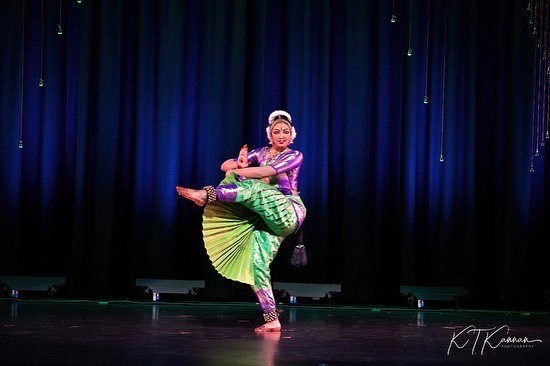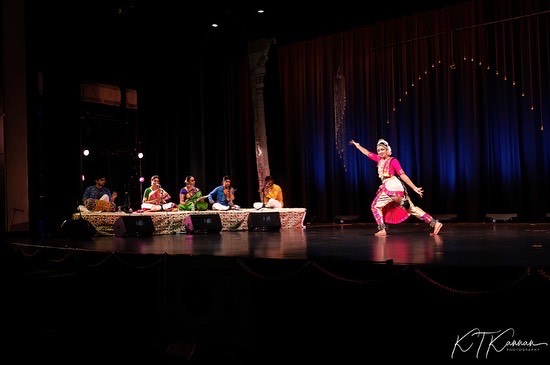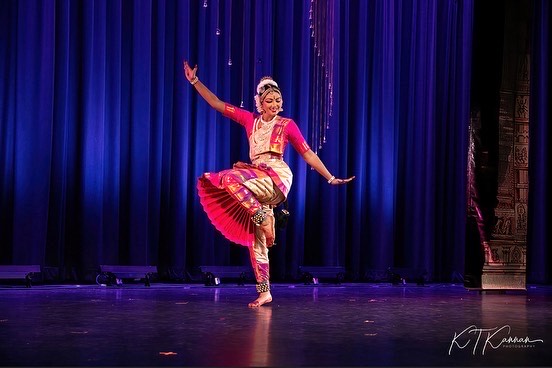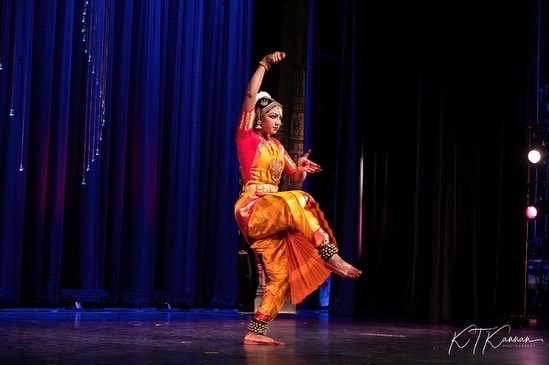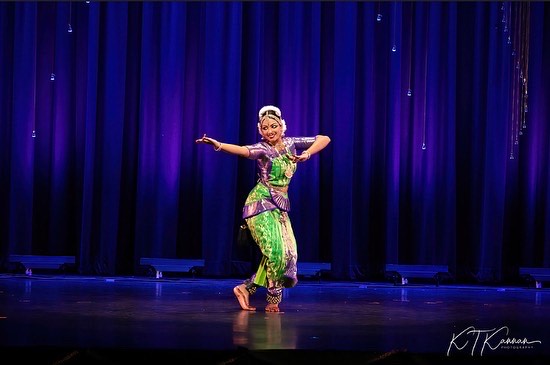Contribute
| Arangetram: Nithila Krishnakumar |
Press Release
08/11/2022
“Arangetram†is a Tamizh word very familiar to classical Indian dancers. A word that means “to ascend the stage†is a solo debut for a dancer to present the results of her years of training. To Nithila Krishnakumar it has been a word that navigated her. Since the first time she saw an Arangetram she became determined it would one day be her on that stage. Fast forward 12 years, and it came true. On July 16, 2022, Nithila Krishnakumar completed her long-awaited Bharatanatyam Arangetram. A day to forever be remembered and constantly wished to be re-lived. Her renown Guru Smt. Jeyanthi Ghatraju along with the rest of the Natyanjali family and many family and friends helped Nithila make this possible. Bharatanatyam has been the purest and oldest classical dance style of India for over three thousand years. Bharatanatyam derives its name from the first three syllables of the three vital elements of dance: Bhavam (expression), Ragam (melody), and Thalam (rhythm). It is an art form that requires mastery of body and mind, discipline, and complete devotion. Bharatanatyam blends pure dance featuring intricate footwork and graceful movements with expressive storytelling of ancient Hindu epics and mythology. Nithila’s Bharatanatyam program was initiated with a Ganesha shloka, to start on the right foot and be blessed by the deity who removes obstacles and as well as the Lord of wisdom and prosperity. Vocalist Visalini Sundaram enthralled the audience with this piece and began the first half. The invocation piece was Natana Poojai Sey Vom, a “Pushpanjali†which is an offering of flowers to the Hindu deities and salutation to the Lord of dance: Nataraja, her Guru, the musicians, and the audience. This piece is in Ragam: Hamsadhvani, Talam: Rupakam, and is composed by Yogi Suddhananda Bharathi. The lyrics invite all to offer salutations in the form of dance according to rituals by Sage Bharatha. This 9-minute piece immerses Navarasa which means 9 emotions, which are Shringaram/Love, Hasya/Laughter, Karuna/Compassion, Adbhutam/Wonder, Bibhatsa/Disgust, Veera/Bravery, Raudra/Anger, Bhayanak/Fear, and Shantam/Peace. These are the 9 main expressions or bhavam of Bharatanatyam which were portrayed by Nithila passionately, making the distinctions between each clear to the audience. Giving the audience a peek into her abhinaya capability. The 4 main instruments of dance were also a part of this dance, beginning with the string instruments the harp, flute, and then the rhythm aspect with the Mridangam, and Nattuvangam. This piece introduced many key parts of this beautiful art form combined with a few basic adavus making it an elegant beginning. Next followed the Alarippu in Misra Nadai (7 beat cycle) translates to “flowering bud.†This is a rhythmic piece that is solely influenced by the mridangam and the nattuvangam. Beginning with neck and eye movements, then opening up the upper body which is soon followed by the entire body, which crisply dances along to the tempo of the music. This is a brisk piece that further introduces the audience to the art form Bharatanatyam through a series of nritta movements. Although, this piece is one of the first to be learned, Nithila showed her skills through graceful yet firm movements and a beautiful smile that could be seen from just her eyes. The 3rd piece was the Jathiswaram in Ragam: Bahudari, Talam: Adi, and composed by Kanagmani Vijayendra. This is a pure dance lasting about 9 minutes. The Jathiswaram is a combination of reminiscent steps and delicate ones all executed perfectly to the talam. This piece follows a pattern in which there are swara passages. As Nithila’s Guru often quotes from the Natya Shastra, “Where the hands go the eyes follow [anubhava], where the eyes go the mind follows [sattvika abhinaya], where the mind goes the mood [bhava] follows, where the mood goes there is rasa born.†The Jathiswaram performed by Nithila was shaped by embracing this quote. The next piece uses bhavam to help the audience understand the Hindu mythology being shared. The Mayil Kavuthuvam in Ragam: Shanmukhapriya, Talam: Talamalika, was set to lyrics by Saint Arunagirinathar’s mayil virutham by Dr Lakshmi Ramaswamy. Mayil translates from Tamizh to peacock in English, since the peacock is Lord Muruga/Subrahmanya’s vehicle Nithila entranced the audience by telling them two stories in praise of the peacock. The first being when a trouble maker brings a delicious fruit to Shiva and says only one person can eat it it cannot be cut. Shiva says but i have two children, Murugan and Ganesha, but only one fruit. How am I going to choose? Then he gets hit with an idea, whoever goes around the world and comes back the fastest gets the fruit. Murugan says okay and calls his peacock to make the journey. The second story is the story of how the peacock became Murugan’s vehicle. When a Asura (demon) was wreaking havoc, Parvati collected all her powers and gave it to Murugan and blessed him, so he could defeat the demon and stop the asura. Murugan takes the powers and blessings and goes to find the demon. He splits the asura in half and the first half of him becomes his flag and the second part becomes a peacock to be his vehicle. Powerful expressions and clear storytelling made the story come to life on stage. During the costume change before the central piece of the Margam, the musicians beautifully showed off their talents. Mridangist: Shashank Iswara, Violinist: Karthik Iyer, and Flutist: Naresh Vytheeswaran were all introduced to the audience by Smt. Jeyanthi Ghatraju, quickly recognized for their stupendous talents. It came as a shock to the audience of how young they are with the oldest musician being 32. Karthik and Shashank are both attending prestigious colleges studying and Naresh is a rising senior in high school. Visalini teaches Bharatanatyam as well as Carnatic music too. None of them have played together before but came together like they were always meant to. Visalini’s euphonious voice, Karthik’s mesmerizing violin, Shawshank’s talented mridangam playing, and Naresh’s melodious flute playing came together so cohesively. It was truly inspiring to see such young talent. To help the audience have a deeper understanding and better connection to the Hindu epic, before Nithila began her Dasavataram Varnam Smt. Jeyanthi Ghatraju gave a short summary on each reincarnation while Nithila acted parts out. Dasavataram is the 10 reincarnations of the God Vishnu, he begins as a sea creature eventually developing into a civilized human. The first reincarnation is the Matsya (fish), Kurma (turtle), Varaha (boar), Narasimha (half beast half human), Vamana (dwarf), Parashurama (devoted warrior), Rama, Krishna, Buddha, and Kalki (last reincarnation to come in the future). Devaki Nandana in Ragam: Thilang, Talam: Adi, and composed by Saint Madhvacharya is the elaborate and complex varnam Nithila performed. With a beautiful, energetic trikala jathi starting the piece the stories capture the audience and keep them engaged. By the end, the audience was in awe and overwhelmed with infatuation. The second half began with Shakthi Koothu in Ragam: Shiva Shakthi, Talam: Adi, and composed by Mahakavi Subramania Bharatiyar. This piece emphasizes feminine energy in the form of goddess Shakthi. It is an enchanting piece that captures how much power and strength she harnesses, Nithila mimicked her spirit and embraced the goddess to leave a powerful take. The 2nd piece was a slower more melodic piece, Sri Ramachandra Kripalu, in Ragam: Purvi, Talam: Adi, and composed by Saint Tulsidas. This is a devotional poem on Lord Rama glorifying his commendable characteristics. This 16th-century composition was written in a mix of Sanskrit and Awadhi. This is a piece with no nritta and focused mainly on expression and explained sloka's through hastas. Nithila created a flow of poise and effortless actions to provide the audience with a change. The next piece was a thrilling dance about Shiva, a folk dance Kavadi Chindu in Ragam: Senchurutti, Talam: Adi, and composed by Dr. K. Sivaloganathan. This piece mixes more folk-style dance steps with Bharatanatyam and has lyrics about the divine Shiva. This was a crowd favorite with how exhilarating and relatable it was. The final piece to Nithila’s Arangetram was the Thilana in Ragam: Khamas, Talam: Adi, and by composer Lalgudi G. Jayaraman. Similar to most Thilanas this piece was full of lively movements and a dance of pure joy. Nithila’s smile was contagious throughout this dance. In honor of her Chithappa’s passing this Murgan piece was dedicated to him. It held a special meaning to all her family and she hopes he was proud from above. Finally, the closing Mangalam, she thanked Nataraja for all the blessings, the Nattuvangam for its grace, her amazing guru, the musicians, and then completed her Namaskaram and thanked the audience. This is the moment all dancers are eagerly waiting for, somehow, this felt like just the beginning to Nithila.
You may also access this article through our web-site http://www.lokvani.com/
